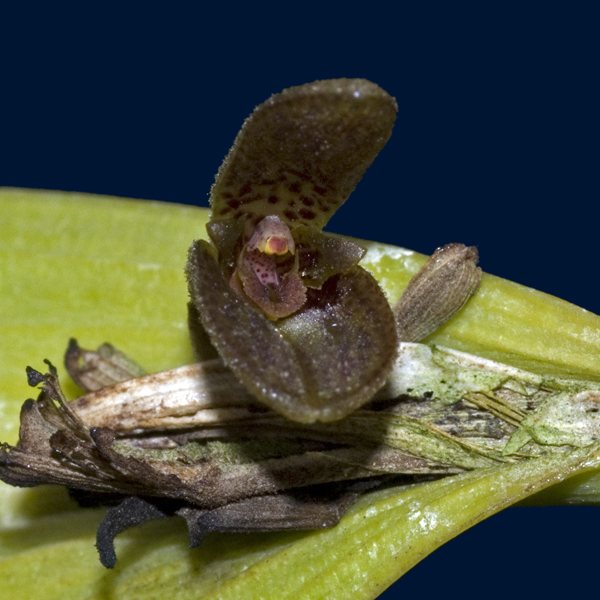

!Echinosepala aspasicensis (Rchb. f.) Pridgeon & M.W. Chase 2002
Photo by The Ecuagenera Website
Photo by Nigel Carter
drawing of Myoxanthus balaeniceps by © by Carl Luer

 to
to 
 and
and 
Common Name The Aspasica Echinosepala [Town in the province of Santander, Colombia]
Flower Size .4" [1 cm]
Found from Costa Rica south to Bolivia, Venezuela, Guyana and Brazil in cloud forests as a medium sized, warm to cool growing epiphyte of moist forests, but it can also be encountered growing as a lithophyte or terresrial on sandstone outcrops in open habitats of southern Venezuela, at elevations of 550 to 1900 meters with stout, erect ramicauls enveloped by 6 to 8 loose, tubular sheaths carrying a single, apical, erect, thickly coriaceous, narrowly elliptical, subacute leaf that is cuneate below into the conduplicate, sessile base that blooms in the winter and spring on a fascile of one to several, reptilian, singular flowers ariseing from the deep cleft of the conduplicate base of the leaf.
"Closely related to Echinosepala uncinata but distinguished by the usually larger, not widely spread flower with anrrow, horse-shoe-shaped callus above the base of the lip. The callus of E uncinatus is broad, smooth, slightly concave and plate-like. One to several, large, darkly colored, reptilian flowers are borne simultaneously in a fascile deep within the cleft of the conduplicate base of the leaf." Luer 1992
Synonyms Brenesia aspasicensis (Rchb.f.) Luer 2004; Echinella aspasicensis (Rchb.f.) Pridgeon & M.W.Chase 2001; Humboldtia aspasicensis (Rchb.f.) Kuntze 1891; Humboltia aspasicensis (Rchb. f.) Kuntze 1891; Myoxanthus alexanderae (Schltr.) Luer 1922; Myoxanthus aspasicensis (Rchb. f.) Luer 1986; Myoxanthus pastacensis (Luer) Luer 1986; Pleurothallis alexandrae Schltr. 1923; *Pleurothallis aspasicensis Rchb. f. 1855; Pleurothallis pastacensis Luer 1976
References W3 Tropicos, Kew Monocot list , IPNI ;
Bonplandia (Hannover) 3: 73 Rchb.f 1855 as Pleurothallis aspacensis;
Repert. Spec. Nov. Regni Veg. Beih. 19: 103 Schltr 1923 as Pleurothallis alexandrae;
Selbyana 3: 44 Luer 1976 as Pleurothallis alexandre drawing fide;
Selbyana 3: 156 Luer 1976 as P pastacensis drawing fide;
Icones Pleurothallidinarum Vol I Systematics of Pleurothallis Luer 1986 as Myoxanthus aspasicensis;
Icones Pleurothallidinarum Vol IX Systematics of Myoxanthus Luer 1992 as Myoxanthus aspasciensis drawing fide;
Icones Pleurothallidinarum Vol XII Systematics of Brachionidium Luer 1995 as Pleurothallis aspasciensis;
Orchids of Bolivia Vol 1 Pleurothallidinae Vasquez & Ibisch 2000 as Pleurothallis aspacensis drawing good;
Lindleyana Vol 16 No 4:253 Pridgeon & Chase 2001 as Echinella aspacensis;
* Lindleyana 17(2): 101. (Rchb.f.) Pridgeon & M.W.Chase 2002;
Native Ecuadorian Orchids Vol 4 Dodson 2003 as Pleurothallis aspacensis photo fide;
Flora of the Venezuelan Guayana Vol 7 Steyermark, Berry, Yatskievych and Holst 2003 as Pleurothallis aspacensis;
Manual de Plantas de Costa Rica Vol 3 Hammel, Grayum, Herrera and Zamora 2003 as Pleurothallis aspacensis;
Icones Pleurothallidinarum Vol XXVI Pleurothallis subgenus Acianthera, A second century of Stelis of Ecuador, Epibator, Ophidion and Zootrophion Luer 2004 as Brenesia aspacensis;
Vanishing Beauty, Native Costa Rican Orchids Vol 1 Pupulin 2005 photo fide;
Orchids of Costa Rica Vol 5 Morales 2009 as Pleurothallis aspasicensis photo ok;
LANKESTERIANA 17(2): Pupulin 2017 photo fide;
--------------------------------------------------------------------------------------------------------------------------
------------------------------------------------------------------------------------------------------------